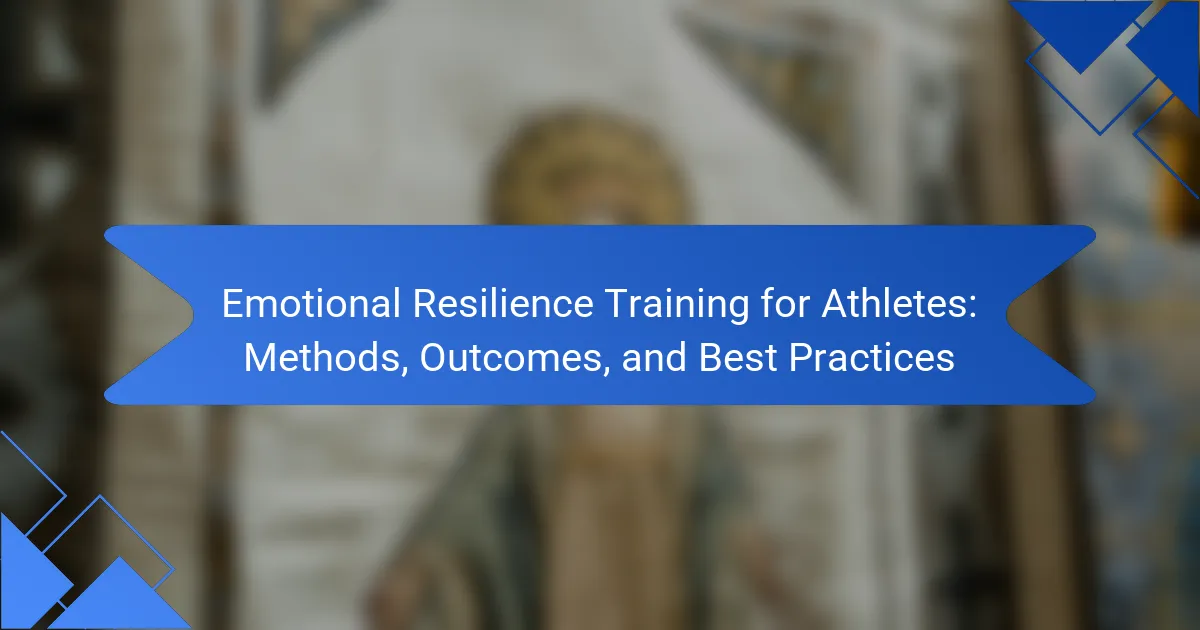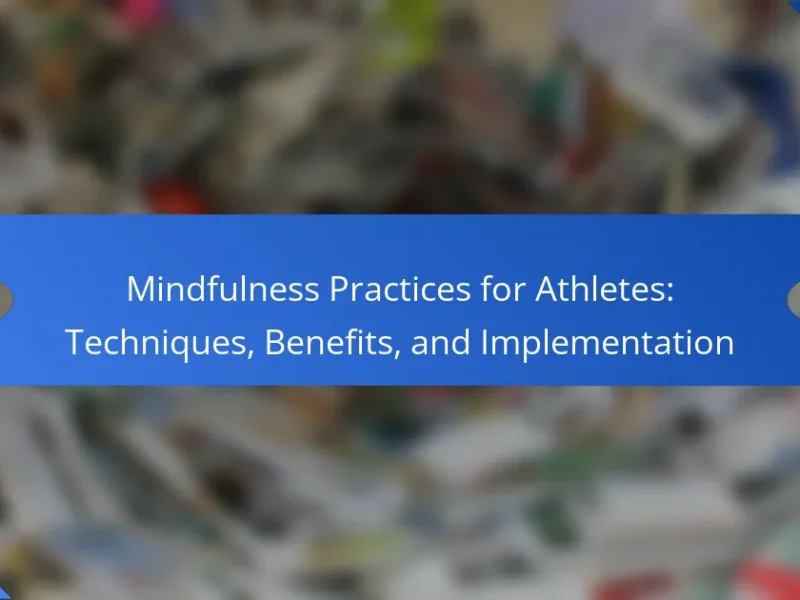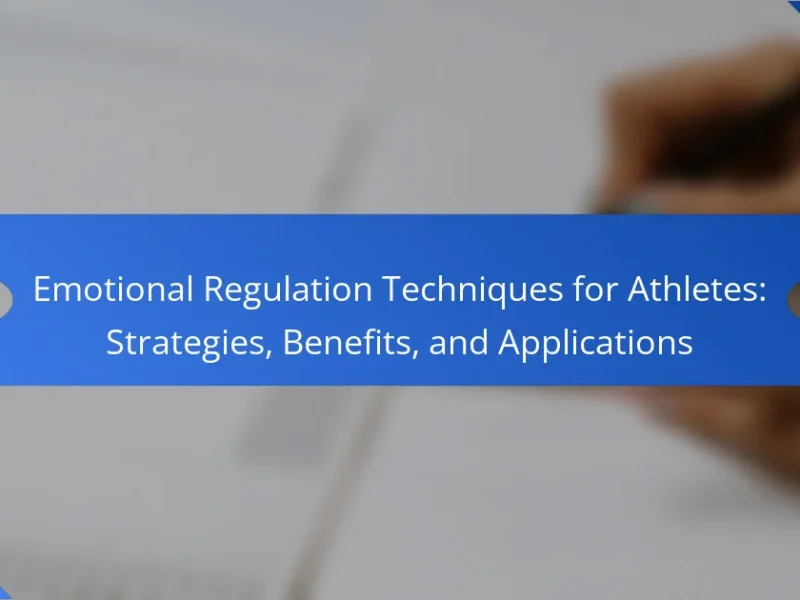Emotional resilience training for athletes significantly improves their ability to manage stress and perform under pressure. This article explores effective methods such as cognitive restructuring and mindfulness practices, highlights positive outcomes like reduced anxiety and enhanced focus, and discusses best practices for integrating these techniques into athlete development. Additionally, it examines the influence of cultural factors on training approaches, emphasizing the need for personalized programs to maximize effectiveness.
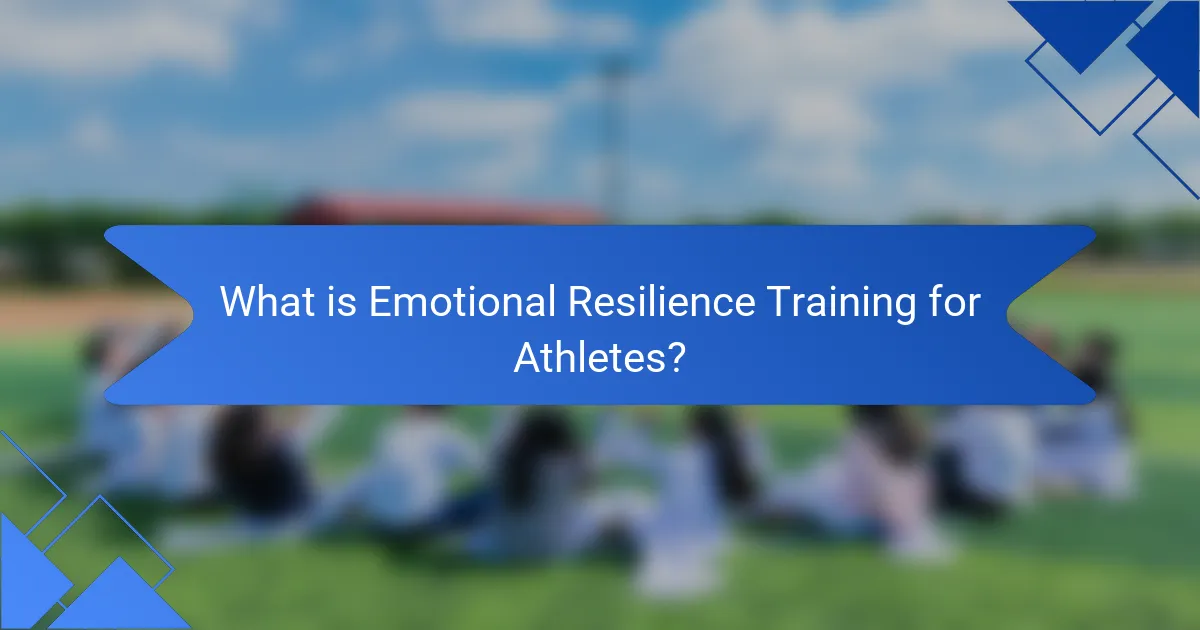
What is Emotional Resilience Training for Athletes?
Emotional resilience training for athletes enhances their ability to cope with stress and adversity. This training typically involves techniques such as cognitive restructuring, mindfulness practices, and goal-setting. Research indicates that athletes who undergo this training show improved performance, reduced anxiety, and better emotional regulation. Best practices include personalized programs, regular assessments, and integrating resilience training into overall athlete development.
How does it differ from traditional mental training?
Emotional resilience training focuses on developing mental strength and coping strategies, unlike traditional mental training that emphasizes skill enhancement. Traditional methods often prioritize performance metrics, while resilience training cultivates adaptability and emotional regulation. This unique approach equips athletes to handle stress and adversity effectively, fostering a more holistic development. Emotional resilience training enhances long-term mental well-being, which is a rare focus in conventional mental training.
What are the key components of emotional resilience?
Key components of emotional resilience include self-awareness, emotional regulation, optimism, and social support. These attributes enable athletes to cope with stress, adapt to challenges, and maintain focus during competition. Training methods often incorporate mindfulness practices, cognitive-behavioral strategies, and peer support systems to enhance these skills. As a result, athletes can improve their performance and well-being.
How does self-awareness contribute to resilience?
Self-awareness significantly enhances resilience by enabling athletes to understand their emotions and reactions. This understanding fosters better coping strategies during stress and challenges. Athletes with high self-awareness can identify their strengths and weaknesses, leading to improved performance and mental agility. Research shows that self-aware individuals are more adaptable, which is crucial in high-pressure sports environments.
What role does emotional regulation play?
Emotional regulation is crucial for athletes as it enhances performance and resilience. It helps manage stress, anxiety, and frustration, leading to improved focus and decision-making. Athletes who master emotional regulation can maintain composure under pressure, facilitating better outcomes in competitions. This skill is often cultivated through emotional resilience training, which equips athletes with techniques to navigate emotional challenges effectively.
Why is social support important?
Social support is crucial for emotional resilience training in athletes as it enhances coping strategies and reduces stress. Support from coaches, teammates, and family fosters a positive environment that promotes mental well-being. Research indicates that athletes with strong social networks experience better performance outcomes and greater psychological resilience. This connection can lead to improved focus, motivation, and overall mental health, making social support an essential component of successful training programs.

What are the universal benefits of emotional resilience training?
Emotional resilience training offers athletes improved stress management, enhanced focus, and better performance under pressure. These benefits stem from methods that teach coping strategies, mindfulness, and emotional regulation. Athletes who engage in such training often report increased confidence and reduced anxiety, leading to more consistent performance outcomes. As a result, emotional resilience training becomes a vital component in an athlete’s overall development.
How does it enhance performance under pressure?
Emotional resilience training enhances performance under pressure by equipping athletes with coping strategies. These methods foster mental toughness, enabling better focus and emotional regulation during high-stress situations. Research shows that athletes with strong emotional resilience experience reduced anxiety and improved decision-making. This training often includes mindfulness practices, cognitive restructuring, and visualization techniques, which collectively enhance an athlete’s ability to perform consistently despite external pressures.
What impact does it have on injury recovery?
Emotional resilience training positively impacts injury recovery by enhancing mental strength and coping strategies. Athletes who undergo this training often experience reduced anxiety and improved focus, which can accelerate healing. Research indicates that resilience training can lead to a 20% faster recovery time compared to those without such training. This approach fosters a proactive mindset, enabling athletes to engage in rehabilitation more effectively and maintain motivation throughout the recovery process.
How does it improve overall mental health?
Emotional resilience training improves overall mental health by enhancing coping skills and emotional regulation. It fosters a growth mindset, enabling athletes to manage stress effectively. For example, studies show that athletes with strong emotional resilience report lower anxiety levels and improved focus during competitions. This training also promotes social support networks, which are crucial for mental well-being. As a result, athletes experience greater satisfaction and performance consistency.
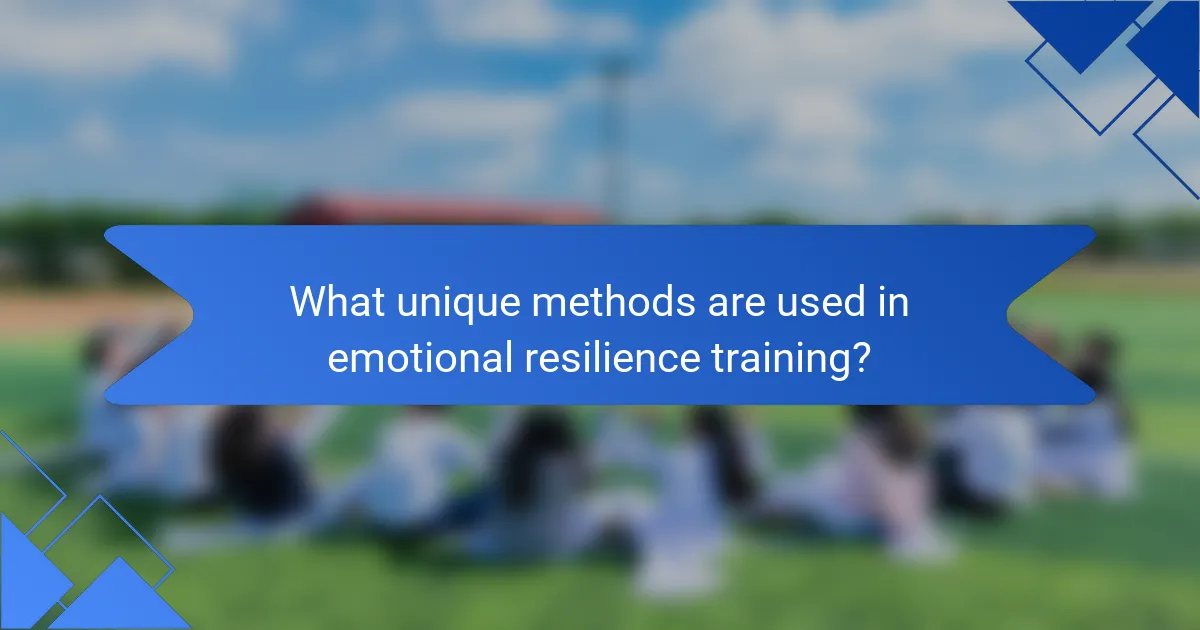
What unique methods are used in emotional resilience training?
Emotionally resilient training for athletes employs unique methods such as mindfulness practices, cognitive restructuring, and visualization techniques. These approaches enhance mental strength and coping mechanisms, leading to improved performance under pressure. Mindfulness increases present-moment awareness, while cognitive restructuring helps athletes reframe negative thoughts. Visualization enables athletes to mentally rehearse successful performances, building confidence and reducing anxiety.
What role do cognitive-behavioral techniques play?
Cognitive-behavioral techniques enhance emotional resilience in athletes by promoting positive thought patterns and coping strategies. These methods help athletes identify and challenge negative beliefs, leading to improved performance under pressure. Techniques such as cognitive restructuring and mindfulness training foster self-awareness and emotional regulation, crucial for maintaining focus and composure. As a result, athletes can better manage stress and recover from setbacks, ultimately enhancing their overall mental toughness.
How can visualization techniques be applied?
Visualization techniques can enhance emotional resilience in athletes by improving focus and reducing anxiety. Techniques such as guided imagery and mental rehearsal allow athletes to mentally simulate performance scenarios, fostering confidence and reducing stress. These practices can lead to improved outcomes in training and competition, promoting a positive mindset and emotional stability.
What is the significance of goal setting in training?
Goal setting is crucial in training as it enhances focus, motivation, and performance. Clear goals provide direction, enabling athletes to track progress and adjust strategies. This process builds emotional resilience, allowing athletes to overcome challenges and setbacks. Research indicates that athletes with specific, challenging goals demonstrate improved outcomes compared to those without defined objectives.

What rare attributes can be found in elite emotional resilience training programs?
Elite emotional resilience training programs may include rare attributes such as personalized neurofeedback techniques, advanced visualization strategies, biofeedback integration, and access to elite mental performance coaches. These unique elements enhance athletes’ mental fortitude and adaptability under pressure, setting these programs apart from standard training.
How do personalized training plans enhance outcomes?
Personalized training plans significantly enhance outcomes by tailoring strategies to individual athlete needs. This customization improves emotional resilience, allowing athletes to manage stress and recover from setbacks more effectively. Research shows that personalized approaches lead to higher engagement and better performance metrics. By focusing on unique attributes such as an athlete’s psychological profile, these plans foster motivation and adaptability, crucial for success in competitive environments.
What is the role of technology in training programs?
Technology enhances emotional resilience training for athletes by providing tools for assessment, practice, and feedback. Digital platforms facilitate personalized training experiences, enabling athletes to engage in simulations and scenarios that build coping strategies. Wearable devices track physiological responses, offering insights into stress management. Additionally, online resources and apps support ongoing learning and community connection, fostering a supportive environment. These technological advancements improve training outcomes by making emotional resilience skills more accessible and measurable.
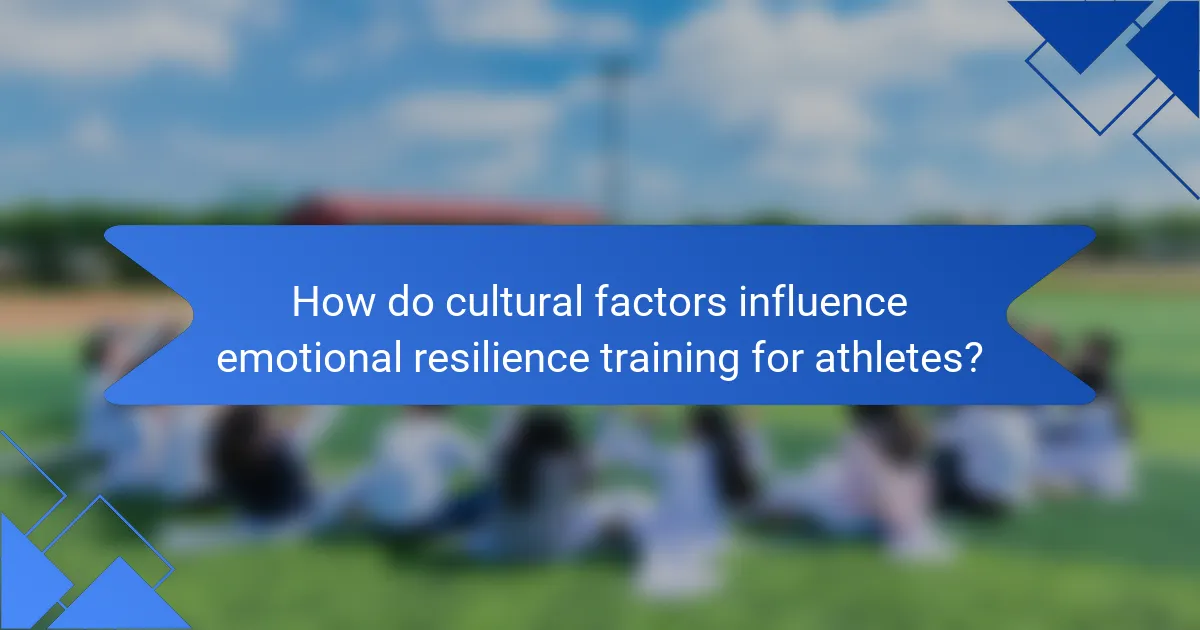
How do cultural factors influence emotional resilience training for athletes?
Cultural factors significantly influence emotional resilience training for athletes by shaping their coping strategies and support systems. Different cultures prioritize various emotional expressions and resilience techniques, impacting training methods. For instance, collectivist cultures may emphasize community support, while individualistic cultures might focus on personal accountability. Understanding these cultural nuances enhances the effectiveness of training programs, tailoring them to meet the specific needs of diverse athlete populations. This cultural adaptability is a unique attribute that can lead to improved outcomes in emotional resilience training.
What regional practices are effective in resilience training?
Regional practices effective in resilience training include culturally tailored methods that resonate with athletes. For instance, indigenous practices often incorporate community support and storytelling, fostering a sense of belonging. In contrast, Eastern philosophies may emphasize mindfulness and meditation, enhancing emotional regulation. Additionally, team-building exercises prevalent in various cultures promote collaboration and trust among athletes, essential for resilience. These practices not only improve mental toughness but also create a holistic environment that supports athletes’ emotional well-being.
How do athletes from different backgrounds perceive emotional resilience?
Athletes from different backgrounds perceive emotional resilience through varied lenses influenced by cultural, social, and personal experiences. These perceptions shape their training methods and coping strategies. For example, athletes from collectivist cultures may emphasize community support, while those from individualistic backgrounds might focus on personal accountability. Emotional resilience training outcomes can vary, with some athletes reporting improved mental health and performance. Best practices involve tailoring approaches to respect these diverse perspectives, ensuring inclusivity in training programs.
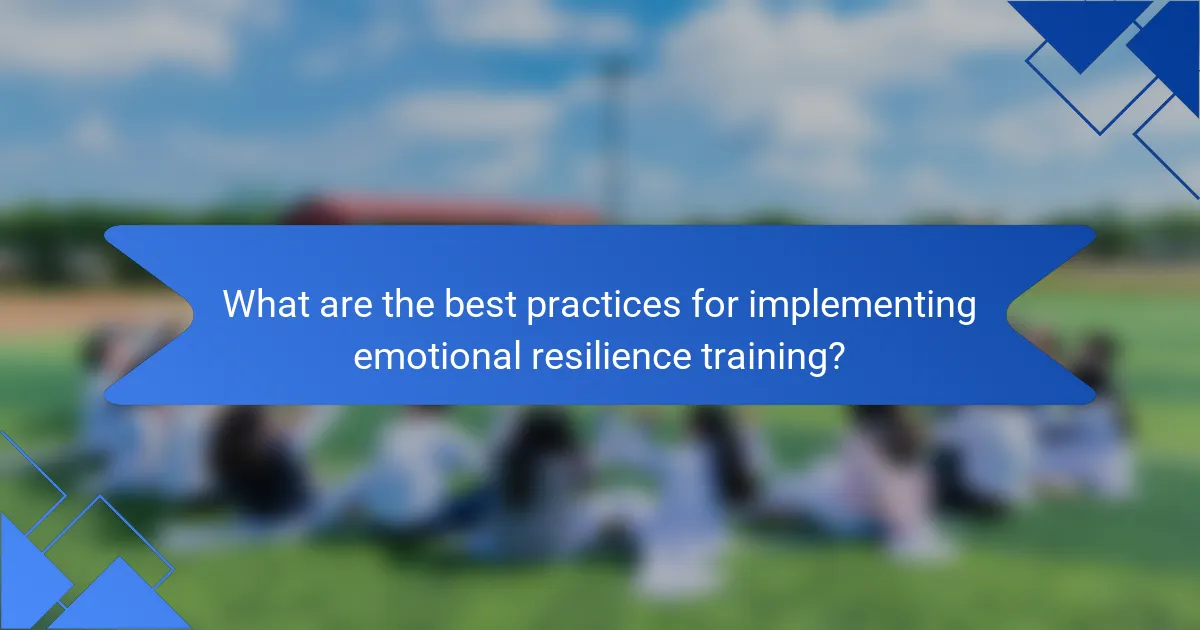
What are the best practices for implementing emotional resilience training?
To implement emotional resilience training effectively, focus on structured programs that promote self-awareness, coping strategies, and mental flexibility. Incorporate techniques such as mindfulness, cognitive-behavioral approaches, and goal-setting. Regular assessments of progress and feedback loops enhance outcomes. Engaging athletes in group discussions fosters a supportive environment, reinforcing shared experiences and learning.
What common mistakes should be avoided?
Athletes should avoid common mistakes like neglecting mental skills, underestimating emotional training, and lacking consistency. Failing to set specific goals can hinder progress. Ignoring recovery and self-care practices also impacts resilience negatively. Lastly, not seeking feedback from coaches or peers can limit growth opportunities.
How can coaches effectively support athletes in this training?
Coaches can effectively support athletes in emotional resilience training by creating a safe environment, fostering open communication, and implementing tailored strategies. Building trust encourages athletes to express their feelings and challenges. Techniques like mindfulness, visualization, and positive self-talk can enhance emotional strength. Regular feedback and goal-setting further empower athletes, promoting a sense of achievement and resilience.
What are the key takeaways for athletes seeking to improve their resilience?
Athletes can enhance their resilience through targeted emotional training. Key takeaways include developing self-awareness, practicing mindfulness, and setting realistic goals. These methods foster a growth mindset, enabling athletes to adapt to challenges. Incorporating regular mental conditioning sessions can lead to improved performance under pressure.
